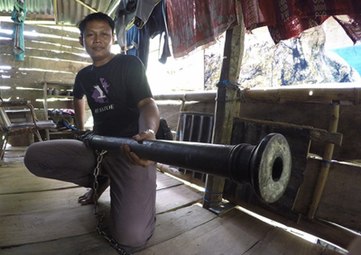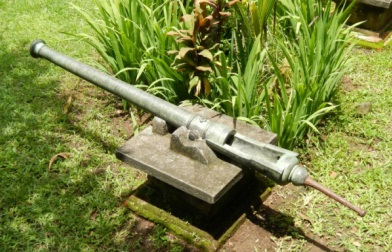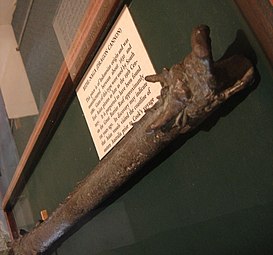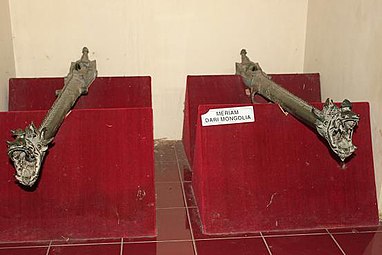Cetbang

| Part of a series on |
| Cannon |
|---|
 |
| History |
|
| Operation |
| By country |
|
| By type |
|
The Cetbang (also known as bedil, warastra, or coak) refers to cannons produced and used by the Majapahit Empire (1293–1527) and other kingdoms in the Indonesian archipelago. There are 2 main types of cetbang: the eastern-style cetbang which looks like a Chinese cannon and is loaded from the front, and the western-style cetbang which is shaped like a Turkish and Portuguese cannon, loaded from the back.[1]: 97–98
Etymology[]
The word "cetbang" is not found in old Javanese, it probably comes from the Chinese word chongtong (銃筒), which also influenced the Korean word 총통(chongtong).[1]: 93 The term "meriam coak" is from the Betawi language, it means "hollow cannon", referring to the breech.[2][3] It is also simply referred to as coak.[4]: 10
Cetbang in old Javanese is known as bedil.[1][5][6] It is also called a warastra, which is synonymous with bedil.[7]: 246 Warastra is an old Javanese word, it means magic arrow, powerful arrow, awesome arrow, or superior arrow.[8]: 108, 132
In Java, the term for cannon is called bedil,[9] but this term may refer to various type of firearms and gunpowder weapon, from small matchlock pistol to large siege guns. The term bedil comes from wedil (or wediyal) and wediluppu (or wediyuppu) in Tamil language.[10] In its original form, these words refer to gunpowder blast and saltpeter, respectively. But after being absorbed into bedil in Malay language, and in a number of other cultures in the archipelago, that Tamil vocabulary is used to refer to all types of weapons that use gunpowder. In Javanese and Balinese the term bedil and bedhil is known, in Sundanese the term is bedil, in Batak it is known as bodil, in Makasarese, badili, in Buginese, balili, in Dayak language, badil, in Tagalog, baril, in Bisayan, bádil, in Bikol languages, badil, and Malay people call it badel or bedil.[10][11][12]
Description[]
There are 2 main type of cetbang:
Eastern-style cetbang[]

Its predecessors were brought by the Mongol-Chinese troops to Java, so they resembled Chinese cannons and hand cannons. Eastern-style cetbangs were mostly made of bronze and were front-loaded cannons. It fires arrow-like projectile, but round bullets and co-viative projectiles[note 1] can also be used. These arrows can be solid-tipped without explosives, or with explosives and incendiary materials placed behind the tip. Near the rear, there is a combustion chamber or room, which refers to the bulging part near the rear of the gun, where the gunpowder is placed. The cetbang is mounted on a fixed mount, or as a hand cannon mounted on the end of a pole. There is a tube-like section on the back of the cannon. In the hand cannon type cetbang, this tube is used as a place to stick poles.[1]: 94 The arrow-throwing cetbang would have been useful in naval combat especially as a weapon used against ships (mounted under the bow gun shield or apilan), and also in siege, because of its projectile ability to explode and as incendiary material.[1]: 97
Western-style cetbang[]

The Western-style cetbang was derived from the Turkish prangi cannon that came to the archipelago after 1460 AD. Just like prangi, this cetbang is a breech-loading swivel gun made of bronze or iron, firing single rounds or scattershots (a large number of small bullets). In order to achieve a high firing speed, 5 chambers can be alternately reloaded.[1]: 94–95, 98
For the rear-loading cetbang, the smallest may be about 60 cm long, and the largest about 2.2 m. Their calibers range from 22 mm to 70 mm.[1]: 97 They are light, mobile cannons, most of them can be carried and shot by one man,[13]: 505 but they are not used like a bazooka because the high recoil force could break human bones.[1]: 97 These gun are mounted on swivel yoke (called cagak), the spike is fitted into holes or sockets in the bulwarks of a ship or the ramparts of a fort.[14] A tiller of wood is inserted to the back of the cannon with rattan, to enable it to be trained and aimed.[13]: 505
Cetbang can be mounted as fixed gun, swivel gun, or placed in a wheelled carriage. Small sized cetbang can be easily installed on small vessels called penjajap and lancaran. This gun is used as an anti-personnel weapon, not anti-ship. In this age, even to the 17th century, the Nusantaran soldiers fought on a platform called balai (see picture of ship below) and perform boarding actions. Loaded with scattershots (grapeshot, case shot, or nails and stones) and fired at close range, the cetbang is very effective at this type of fighting.[7]: 241 [15]: 162
History[]
Majapahit era (ca. 1300–1478)[]

Cannons were introduced to Majapahit when Kublai Khan's Chinese army under the leadership of Ike Mese sought to invade Java in 1293. History of Yuan mentioned that the Mongol used a weapon called pao against Daha forces.[16]: 1–2 [17][18] This weapon is interpreted differently by researchers, it may be a trebuchet that throws thunderclap bombs, firearms, cannons, or rockets. It is possible that the gunpowder weapons carried by the Mongol-Chinese troops amounted to more than 1 type.[1]: 97
The Majapahit Kingdom dominated the Nusantara archipelago primarily because it possessed the technology to cast and forge bronze on an early mass production basis. The Majapahit also pioneered the manufacturing and usage of gunpowder weapons on a large scale. The Majapahit Empire was one of the last major empires of the region and is considered to be one of the most powerful empires in the history of Indonesia and Southeast Asia. Thomas Stamford Raffles wrote in The History of Java that in 1247 saka (1325 AD), cannons have been widely used in Java especially by the Majapahit. It is recorded that the small kingdoms in Java that that sought the protection of Majapahit had to hand over their cannons to the Majapahit.[19]: 106 [20]: 61 Majapahit under Mahapatih (prime minister) Gajah Mada (in office 1329–1364) utilized gunpowder technology obtained from Yuan dynasty for use in naval fleet.[21]: 57 One of the earliest reference to cannon and artillerymen in Java is from the year 1346.[22]
The use of cannons was widespread in the Majapahit navy, amongst pirates, and in neighboring kingdoms in Nusantara.[23] A famous Majapahit admiral, , was renowned for his use of cannons. Records of Mpu Nala are known from the Sekar inscription, the Mana I Manuk (Bendosari) inscription, the Batur inscription, and the Tribhuwana inscription which referred to him as Rakryan Tumenggung (war commander).[24] The neighboring kingdom of Sunda was recorded using bedil during battle of Bubat of 1357. Kidung Sunda canto 2 verse 87-95 mentioned that the Sundanese had juru-modya ning bedil besar ing bahitra (aimer/operator of the big cannon on the ships) in the river near Bubat square. Majapahit troops situated close to the river were unlucky: The corpses could hardly be called corpses, they were maimed, torn apart in the most gruesome way, the arms and the heads were thrown away. The cannon balls were said to discharge like rain, which forced the Majapahit troops to retreat in the first part of the battle.[25]: 34, 104–105
Ma Huan (Zheng He's translator) visited Java in 1413 and took notes about the local customs. His book, Yingya Shenlan, mentioned that cannons are fired in Javanese marriage ceremonies when the husband was escorting his new wife to the marital home to the sound of gongs, drums, and firecrackers.[7]: 245
Because of the close maritime relations of the Nusantara archipelago with the territory of West India, after 1460 new types of gunpowder weapons entered the archipelago through Arab intermediaries. This weapon seems to be cannon and gun of Ottoman tradition, for example the prangi, which is a breech-loading swivel gun.[1]: 94–95
Majapahit decline and the rise of Islam (1478–1600)[]

Following the decline of the Majapahit, particularly after the paregreg civil war (1404–1406),[26]: 174–175 the consequent decline in demand for gunpowder weapons caused many weapon makers and bronze-smiths to move to Brunei, Sumatra, the Malay peninsula, or the Philippines. This spread the production and usage of the cetbang, especially for protecting trade ships in the Makassar Strait from pirates. It led to near universal use of the swivel-gun and cannons in the Nusantara archipelago.[23] When the Portuguese first came to Malacca, they found a large colony of Javanese merchants under their own headmen; the Javanese were manufacturing their own cannon, which then, and for long after, were as necessary to merchant ships as sails.[27]
When Iberian explorer came to Southeast Asia, the local population was unimpressed with the might and power of the heavily armed trading vessels of Portugal and Spain. De Barros and Faria e Sousa mentions that with the fall of Malacca (1511), Albuquerque captured 3,000 out of 8,000 artillery. Among those, 2,000 were made from brass and the rest from iron, in the style of Portuguese berço (berso). All of the artillery had its proper complement of carriages which could not be rivalled even by Portugal.[28]: 279 [29]: 22 [30]: 127 The cannons found were of various types: esmeril (1/4 to 1/2-pounder swivel gun,[31] probably refers to cetbang or lantaka), falconet (cast bronze swivel gun larger than the esmeril, 1 to 2-pounder,[31] probably refers to lela), medium saker (long cannon or culverin between a six and a ten pounder, probably refers to meriam),[32][33]: 385 and bombard (short, fat, and heavy cannon).[34]: 46 The Malays also has 1 beautiful large cannon sent by the king of Calicut.[34]: 47 [29]: 22 The large number of artillery in Malacca come from various sources in the Nusantara archipelago: Pahang, Java, Brunei, Minangkabau, and Aceh.[28]: 279 [35]: 124 [36]: 30

Cetbang cannons were further improved and used in the Demak Sultanate period during the Demak invasion of Portuguese Malacca (1513). During this period, the iron, for manufacturing Javanese cannons was imported from Khorasan in northern Persia. The material was known by Javanese as wesi kurasani (Khorasan iron).[37] When the Portuguese came to the archipelago, they referred to it as berço, which was also used to refer to any breech-loading swivel gun, while the Spaniards call it verso.[15]: 151
Colonial era (1600–1945)[]
When the Dutch captured Makassar's fort of Somba Opu (1669), they seized 33 large and small bronze cannon, 11 cast-iron cannon, 145 base (breech-loading swivel gun) and 83 breech-loading gun chamber, 60 muskets, 23 arquebuses, 127 musket barrels, and 8483 bullets.[33]: 384
Bronze breech-loading swivel guns, called ba'dili,[38][39] is brought by Makassan sailor in trepanging voyage to Australia. Matthew Flinders recorded the use of small cannon on board Makassan perahu off the Northern Territory in 1803.[40] Vosmaer (1839) writes that Makassan fishermen sometimes took their small cannon ashore to fortify the stockades they built near their processing camps to defend themselves against hostile Aborigines.[41] Dyer (ca. 1930) noted the use of cannon by Makassans, in particular the bronze breechloader with 2 inch (50.8 mm) bore.[42]: 64 [4]: 10
The Americans fought Moros equipped with breech-loading swivel guns in the Philippines in 1904.[13]: 505 These guns are usually referred to as lantaka or breech-loading lantaka.[43]
Surviving examples[]
| Wikimedia Commons has media related to Cetbang. |
There are surviving examples of the cetbang at:
- The Bali Museum, Denpasar, Bali. This Balinese cannon is located in the yard of Bali Museum.
- The Metropolitan Museum of Art, New York, USA. This cannon is thought to have been produced in the 15th century, made from bronze with dimensions of 37.7 inches (96 cm) x 16 inches (41 cm).[44]
- Luis de Camoes museum in Macau has a piece of highly ornamented cetbang. Year manufactured is unknown.
- Talaga Manggung museum, Majalengka, West Java. Numerous cetbang is in good condition due to routine cleaning ritual.[45]
- Some cetbang can be found in National Museum of Anthropology at Manila.
- Fatahillah Museum has a meriam coak labelled as "Cirebon cannon", in a fixed, highly ornamented mount. The whole mount is 234 cm in length, 76 cm in width, and 79 cm in height.[46]
- Several examples and parts of cetbang can be found in Rijksmuseum, Netherlands, labelled as lilla (lela cannon).
- A cetbang is found in Beruas river, Perak, in 1986. Now it is exhibited in Beruas museum.[47]
Cetbang are also found at:
- Dundee beach, Northern Territory, Australia, known as "Dundee Beach swivel gun". Researchers have concluded that this bronze swivel cannon is from the 1750, before James Cook's voyage to Australia.[48] Initially thought to be Portuguese cannon, researcher has concluded that it is likely originated from Makassar. There is nothing in its chemical composition, style, or form that matches Portuguese breech loading swivel guns.[4]: 11
- Bissorang village, Selayar islands, Sulawesi Selatan province. This cannon is thought to have originated from the Majapahit era. Local people call this cetbang Ba'dili or Papporo Bissorang.[38][39]
- A Mataram-era (1587–1755) cetbang can be found at Lubuk Mas village, South Sumatera, Indonesia.[49]
- A 4-wheeled cetbang can be found at Istana Panembahan Matan in Mulia Kerta, West Kalimantan.[50]
- Two cannons can be found in Elpa Putih village, Amahai sub-district, Central Maluku Regency. It is thought to have originated from 16-17th century Javanese Islamic kingdoms.[51]
- Two cannons, named Ki Santomo and Nyi Santoni, can be found in Kasepuhan Palace (in Cirebon). They are labelled as "Meriam dari Mongolia" (cannon from Mongolia).[52]
Gallery[]

A cetbang found on Selayar island

Cetbang in Bali Museum. Length: 1833 mm. Bore: 43 mm. Length of tiller: 315 mm. Widest part: 190 mm (at the base ring).

Bedil naga (dragon cannon) found on the Great Barrier Reef. Indonesian origin, manufactured between 1630 and 1680. Its discovery indicate that Asian vessels visited the coastline of eastern Australia prior to James Cook voyage.

A bronze sacred gun in Java, with breech-block, ca. 1866. Malay women come and settle accounts with the tutelary deity of this gun, and pray for children.

Breech-loading "lilla", Rijksmuseum, ca. 1750 - 1850. Length 180.5 cm, width 21.5 cm, calibre: 4.5 cm, weight: 120.8 kg.

Meriam coak dubbed "Cirebon cannon" of Jakarta History Museum (Fatahillah Museum).

Two cannons in Keraton Kasepuhan, labelled as cannon from Mongolia. The dragon head is similar to Chinese dragon (long) than Javanese dragon (naga).
Notes[]
- ^ A type of scatter bullet - when shot it spews fire, splinters and bullets, and can also be arrows. The characteristic of this projectile is that the bullet does not cover the entire bore of the barrel. Needham, Joseph (1986). Science and Civilisation in China, Volume 5: Chemistry and Chemical Technology, Part 7, Military Technology: The Gunpowder Epic. Cambridge: Cambridge University Press. pp. 9 and 220.
Similar weapons[]
- Chongtong, Korean cannon adapted from the Yuan and Ming dynasty guns
- Bo-hiya, Japanese fire arrow
- Huochong, Chinese hand cannon
- Bedil tombak, Nusantaran hand cannon
See also[]
- Lantaka
- Breech-loading swivel gun
- Java arquebus, a type of firearm also called a bedil
- Timeline of the gunpowder age
- History of gunpowder
- History of cannon
References[]
- ^ Jump up to: a b c d e f g h i j Averoes, Muhammad (2020). Antara Cerita dan Sejarah: Meriam Cetbang Majapahit. Jurnal Sejarah, 3(2), 89 - 100.
- ^ Museum Nasional (1985). Meriam-Meriam Kuno di Indonesia. Jakarta: Departemen Pendidikan dan Kebudayaan.
- ^ Singhawinata, Asep (27 March 2017). "Meriam Peninggalan Hindia Belanda". Museum Talagamanggung Online. Retrieved 9 February 2019.
- ^ Jump up to: a b c Clark, Paul (2013). Dundee Beach Swivel Gun: Provenance Report. Northern Territory Government Department of Arts and Museums.
- ^ "Mengejar Jejak Majapahit di Tanadoang Selayar - Semua Halaman - National Geographic". nationalgeographic.grid.id (in Indonesian). Retrieved 22 March 2020.
- ^ arthomoro. "MENGENAL CETBANG / MERIAM KERAJAAN MAJAPAHIT DARI JENIS , TIPE DAN FUNGSINYA ~ KOMPILASITUTORIAL.COM". Retrieved 22 March 2020.
- ^ Jump up to: a b c Manguin, Pierre-Yves (1976). "L'Artillerie legere nousantarienne: A propos de six canons conserves dans des collections portugaises" (PDF). Arts Asiatiques. 32: 233–268. doi:10.3406/arasi.1976.1103.
- ^ Mardiwarsito, L. (1992). Kamus Indonesia-Jawa Kuno. Jakarta: Departemen Pendidikan dan Kebudayaan.
- ^ Gardner, G. B. (1936). Keris and Other Malay Weapons. Singapore: Progressive Publishing Company.
- ^ Jump up to: a b Kern, H. (January 1902). "Oorsprong van het Maleisch Woord Bedil". Bijdragen tot de Taal-, Land- en Volkenkunde. 54: 311–312. doi:10.1163/22134379-90002058.
- ^ Syahri, Aswandi (6 August 2018). "Kitab Ilmu Bedil Melayu". Jantung Melayu. Retrieved 10 February 2020.
- ^ Rahmawati, Siska (2016). "Peristilahan Persenjataan Tradisional Masyarakat Melayu di Kabupaten Sambas". Jurnal Pendidikan Dan Pembelajaran Khatulistiwa. 5.
- ^ Jump up to: a b c Ooi, Keat Gin (2004). Southeast Asia: A Historical Encyclopedia, from Angkor Wat to East Timor. ABC-CLIO. ISBN 9781576077702.
- ^ "Cannons of the Malay Archipelago". www.acant.org.au. Retrieved 25 January 2020.
- ^ Jump up to: a b Wade, Geoff (2012). Anthony Reid and the Study of the Southeast Asian Past. Institute of Southeast Asian Studies. ISBN 978-981-4311-96-0.
- ^ Schlegel, Gustaaf (1902). "On the Invention and Use of Fire-Arms and Gunpowder in China, Prior to the Arrival of European". T'oung Pao. 3: 1–11.
- ^ Lombard, Denys (2005). Nusa Jawa: Silang Budaya, Bagian 2: Jaringan Asia. Jakarta: Gramedia Pustaka Utama. Hal. 208.
- ^ Reid, Anthony (2011). Asia Tenggara dalam Kurun Niaga 1450-1680 Jilid II: Jaringan Perdagangan Global. Jakarta: Yayasan Pustaka Obor Indonesia. Hal. 255.
- ^ Raffles, Thomas Stamford (1830). The History of Java. London: John Murray, Albemarle Street.
- ^ Yusof, Hasanuddin (September 2019). "Kedah Cannons Kept in Wat Phra Mahathat Woramahawihan, Nakhon Si Thammarat". Jurnal Arkeologi Malaysia. 32: 59–75.
- ^ Pramono, Djoko (2005). Budaya Bahari. Gramedia Pustaka Utama. ISBN 9789792213768.
- ^ Beauvoir, Ludovic (1870). A Voyage Round the World, Volume 2. J. Murray. p. 91.
- ^ Jump up to: a b Thomas Stamford Raffles, The History of Java, Oxford University Press, 1965, ISBN 0-19-580347-7, 1088 pages.
- ^ "PRASASTI SEKAR". penyuluhbudayabojonegoro.blogspot.co.id. Archived from the original on 6 August 2017. Retrieved 6 August 2017.
- ^ Berg, C. C., 1927, Kidung Sunda. Inleiding, tekst, vertaling en aanteekeningen, BKI LXXXIII : 1-161.
- ^ Hidayat, Mansur (2013). Arya Wiraraja dan Lamajang Tigang Juru: Menafsir Ulang Sejarah Majapahit Timur. Denpasar: Pustaka Larasan.
- ^ Furnivall, J.S (2010). Netherlands India: A Study of Plural Economy. Cambridge University Press. p. 9.
- ^ Jump up to: a b Partington, J. R. (1999). A History of Greek Fire and Gunpowder. JHU Press. ISBN 978-0-8018-5954-0.
- ^ Jump up to: a b Crawfurd, John (1856). A Descriptive Dictionary of the Indian Islands and Adjacent Countries. Bradbury and Evans.
- ^ Albuquerque, Afonso de (1875). The Commentaries of the Great Afonso Dalboquerque, Second Viceroy of India, translated from the Portuguese edition of 1774 volume 3. London: The Hakluyt society.
- ^ Jump up to: a b Manucy, Albert C. (1949). Artillery Through the Ages: A Short Illustrated History of the Cannon, Emphasizing Types Used in America. U.S. Department of the Interior Washington. p. 34. ISBN 9780788107450.
- ^ Lettera di Giovanni Da Empoli, with introduction and notes by A. Bausani, Rome, 1970, page 138.
- ^ Jump up to: a b Tarling, Nicholas (1992). The Cambridge History of Southeast Asia: Volume 1, From Early Times to C.1800. Cambridge University Press. ISBN 9780521355056.
- ^ Jump up to: a b Charney, Michael (2004). Southeast Asian Warfare, 1300-1900. BRILL. ISBN 9789047406921.
- ^ Ismail, Norain B.T. (2012). Peperangan dalam Historiografi Johor: Kajian Terhadap Tuhfat Al-Nafis. Kuala Lumpur: Akademi Pengajian Islam Universiti Malaya.
- ^ Ayob, Yusman (1995). Senjata dan Alat Tradisional. Selangor: Penerbit Prisma Sdn Bhd.
- ^ Anonymous (2020). "Cetbang, Teknologi Senjata Api Andalan Majapahit". 1001 Indonesia. Retrieved 22 March 2020.
- ^ Jump up to: a b "kabarkami.com Is For Sale". www.kabarkami.com. Archived from the original on 6 August 2017. Retrieved 6 August 2017.
- ^ Jump up to: a b Amiruddin, Andi Muhammad Ali (2017). Surga kecil Bonea Timur. Makassar: Pusaka Almaida. p. 15. ISBN 9786026253385.
- ^ Flinders, Matthew (1814). A Voyage to Terra Australis. London: G & W Nichol.
- ^ Vosmaer, J. N. (1839). "Korte beschrijving van het Zuid- Oostelijk schiereiland van Celebes, in het bijzonder van de Vosmaers-Baai of van Kendari". Verhandelingen van Het Bataviaasch Genootschap van Kusten en Wetenschapen. 17: 63–184.
- ^ Dyer, A. J. (1930). Unarmed Combat: An Australian Missionary Adventure. Edgar Bragg & Sons Pty. Ltd., printers 4-6 Baker Street Sydney.
- ^ "National Museum of the Philippines, Part III (Museum of the Filipino People)". Wandering Bakya. 15 August 2014. Retrieved 18 June 2020.
- ^ "Cannon | Indonesia (Java) | Majapahit period (1296–1520) | The Met". The Metropolitan Museum of Art, i.e. The Met Museum. Retrieved 6 August 2017.
- ^ "Museum Talaga Manggung-Dinas Pariwisata dan Kebudayaan Provinsi Jawa Barat". www.disparbud.jabarprov.go.id. Retrieved 30 June 2018.
- ^ "Museum Sejarah Jakarta". Rumah Belajar. Retrieved 9 February 2019.
- ^ Amran, A. Zahid (22 September 2018). "Kerajaan Melayu dulu dah guna senjata api berkualiti tinggi setaraf senjata buatan Jerman | SOSCILI". Retrieved 23 March 2020.
- ^ La Canna, Xavier (22 May 2014). "Old cannon found in NT dates to 1750s". Australian Broadcasting Corporation.
- ^ Rawas, Sukandar. "Meriam kuno Lubuk Mas". Youtube.
- ^ Rodee, Ab (11 August 2017). "Meriam Melayu". Picbear. Retrieved 16 July 2018.
- ^ Handoko, Wuri (July 2006). "Meriam Nusantara dari Negeri Elpa Putih, Tinjauan Awal atas Tipe, Fungsi, dan Daerah Asal". Kapata Arkeologi. 2: 68–87.
- ^ "Palace Kasepuhan-Dinas Pariwisata dan Kebudayaan Provinsi Jawa Barat". www.disparbud.jabarprov.go.id. Retrieved 1 September 2020.
- Naval artillery
- Cannon
- Indonesian inventions
- Weapons of Indonesia
- Weapons of Java
- Indonesian culture
- Malaysian culture
- Weapons of Malaysia
- 15th-century military history
- 14th-century military history
- Javanese culture
- Weapons of the Philippines









